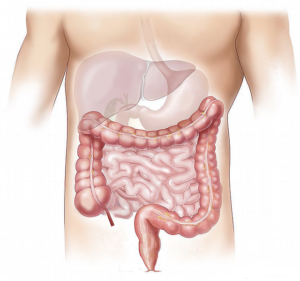Constipation

It may be a difficult topic of conversation, but constipation is a common problem. Around 14% of people struggle with chronic constipation with a higher prevalence in women than men (Suares 2011). Constipation is defined as consistently having a low frequency of bowel movements and/or difficulty in passing stools.
There are three main types of constipation:
Dyssynergic defecation
While the term is a mouthful, dyssynergic defecation is the loss of coordination of the muscles involved in having a bowel movement. The most common cause is poor bowel habits. Examples include straining too much or holding back from having bowel movements repeatedly. Other causes include physical or sexual abuse and structural problems with the colon. Most commonly, dyssynergic defecation consists of excessive straining with difficulty in completing a bowel movement (Rao 2004).
Slow transit constipation
Slow transit is the least common type of constipation. It’s caused by impairment of the normal muscle contractions in the colon (Dinning 2015).
Functional constipation
The most common type of constipation is functional constipation. Unfortunately, it is the least understood (Camilleri 2017). It’s likely a combination of diet and lifestyle factors combined with changes or problems with the normal bacteria found throughout the digestive tract.
Treatment
The initial approach for most cases of constipation starts with standard treatments and watching for improvements. If standard treatments fail, then an evaluation for dyssynergic defecation or slow transit constipation could be warranted.
In rare cases, constipation may indicate a more severe underlying problem. If an adult has recent onset constipation with unexplained weight loss or bloody stools, they should be evaluated for colon cancer (Camilleri 2017). Bloody stools can be scary, although the most common cause is usually hemorrhoids.
Lifestyle factors
Dehydration
If you’re not consuming enough fluids, or you’ve recently lost a lot of fluids through sweating, vomiting or other reasons, you can get dehydrated. Keeping fluid intake at a normal level is important for maintaining bowel movements. Adequate water keeps stools soft and easier to pass. However, there doesn’t appear to be any benefits for drinking more water if you aren’t dehydrated (Arnaud 2003). While rare, it is possible to drink too much water as well (Hew-Butler 2019).
While hydration needs vary by body weight, shooting for 8 cups a day is not unreasonable. If you drink less than 500 mL of water (around 2 cups) a day and struggle with constipation, increasing your hydration is likely a critical component (Fathallah 2017).
Fiber
Consuming more fiber can be helpful for constipation. Fiber is indigestible roughage that adds bulk to stools. Fiber also retains water to keep stools softer for easier passage. Soluble fiber appears best for helping with constipation. The most common type of prescribed fiber is psyllium. Compared to docusate, a standard stool softener, psyllium fiber was shown to work better for constipation (McRorie 1998).
While there are many fiber supplements on the market, the research suggests that soluble, gel-forming, non-digestible fibers work best. Psyllium husk is an example of such a fiber. There is a simple test to evaluate your fiber’s effectiveness for constipation. Place a serving of the fiber in a ½ cup of water and check to see if it forms a gel within 15 minutes (McRorie 2015).
Exercise
Consistent exercise may not help all cases of constipation, but it has been shown to help irritable bowel syndrome. Irritable bowel syndrome may be the cause of constipation for a subset of individuals (Johannesson 2011). Improving digestion is just another reason to include physical activity in your weekly routine.
Diet
Processed foods may be convenient, but they are usually low in fiber. Foods like white bread, chips, sugary cereals, cheese, fried foods, fast food and prepared meals appear to increase risks of gastrointestinal symptoms including constipation (Okawa 2019). Eating more fruits, vegetables, and whole grains can help increase fiber and decrease risks for constipation.
In more severe cases of constipation, a low FODMAP diet is also worth considering. The low FODMAP diet eliminates foods that contain specific fermentable components that seem to make gastrointestinal symptoms worse. The low FODMAP diet is fairly strict. While effective, it can be challenging to implement (Rao 2015). For more information on the low FODMAP diet, see here.
Prunes
A review of the research on prunes for constipation potentially showed that 10 prunes a day improved stool frequency and consistency better than psyllium (Lever 2014). While promising for symptom relief, prunes add significant sugar to the diet amounting to 36 grams or 2 ½ tablespoons of sugar a day. While that doesn’t mean I’m opposed to prunes, you still want to keep in mind their high sugar content.
Supplements
Triphala
Triphala is a combination of three herbs from ayurvedic (Indian) medicine that have a gentle laxative effect that is safe enough to be used daily (Peterson 2017). The combination has historically been used to “tonify” the gastrointestinal tract. The only caution for triphala is to make sure you get it from a trusted source, as Indian herbs are commonly adulterated with heavy metals like lead or mercury (Sadler 2017).
Magnesium
Magnesium is an osmotic laxative that can help with constipation. For some, magnesium supplements may help draw enough water into the colon to keep stools soft enough to relieve constipation.
Magnesium comes as a salt, and the types of magnesium that work best for constipation are poorly absorbed, so they stay in the digestive tract. Examples include magnesium oxide, magnesium hydroxide and magnesium sulfate. Keep in mind that you can take too much magnesium. For normal healthy individuals, I usually don’t recommend over 600 mg of magnesium per day for continuous use (Bokhari 2018).
Vitamin C
The most common side effect of taking too much vitamin C is diarrhea. This effect can be used to treat constipation. For occasional constipation, taking higher doses of vitamin C can draw water into the colon and help bring relief.
Probiotics
While the research results are still not conclusive, probiotics may benefit constipation (Miller 2017). In a recent review, authors concluded that probiotics containing lactobacillus or bifidobacteria increase bowel movements by almost one per week and decrease the transit time of food through the gastrointestinal tract by about 15 hours. Both of these results suggest probiotics may be helpful for relieving constipation.
Senna
One of the more common natural laxatives that people use is senna. Senna is an herbal stimulant laxative that causes contractions of the digestive tract to help with constipation. Since senna is a stimulant laxative there have been concerns that long-term use may weaken bowel contractions. However, the latest research does not appear to show risks when senna is used in reasonable quantities (Vilanova-Sanchez 2018).
Another potential side effect of senna is a rare anal rash that can include redness and blisters after prolonged use. All considered, I’d still like to see more evidence of safety with senna before recommending its use for long-term constipation control. I usually prefer other approaches first.
Conclusion
Constipation can be a very uncomfortable and frustrating condition. As outlined above, there are a number of practical, natural options worth considering that in a majority of cases can bring relief. If constipation is not improving with treatment, it’s worth talking to your doctor to consider ruling out other types of constipation that may need a different treatment approach.




fantastic points altogether, you simply gained a brand new reader.
Pingback: How Much Water Should I Drink? - Buesing Naturopathic